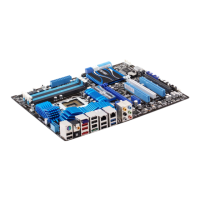
Do you have a question about the Asus P8P67 DELUXE and is the answer not in the manual?
| Chipset | Intel P67 |
|---|---|
| CPU Socket | LGA 1155 |
| Memory Type | DDR3 |
| Memory Slots | 4 x DIMM |
| Max Memory | 32GB |
| Memory Standard | DDR3 2200(O.C.)/2133(O.C.)/1866(O.C.)/1600/1333/1066 MHz |
| Form Factor | ATX |
| SATA 6Gb/s Ports | 4 x SATA 6Gb/s |
| SATA 3Gb/s Ports | 4 x SATA 3Gb/s |
| LAN | Dual Gigabit LAN |
| USB 2.0 Ports | 12 x USB 2.0 |
| Expansion Slots | 2 x PCIe 2.0 x1, 2 x PCI |
| Audio | 8-Channel High Definition Audio |
| USB 3.0 Ports | 2 x USB 3.0 (rear), 2 x USB 3.0 (front) |
Explains ASUS's dual intelligent processors and DIGI+ VRM technology.
Lists important precautions before installing components or changing settings.
Details the CPU socket and installation considerations.
Explains DIMM slots and DDR3 memory installation.
Describes the PCIe and PCI slots and their configurations.
Step-by-step guide for installing the CPU onto the motherboard socket.
Instructions for installing the CPU heatsink and fan assembly.
Step-by-step guide for installing RAM modules into DIMM slots.
Instructions for installing the motherboard into the PC chassis.
Guides on connecting ATX power supply cables to the motherboard.
Instructions for connecting SATA hard drives and optical drives.
Instructions for installing PCIe x16, PCIe x1, and PCI expansion cards.
Details the steps for assembling a PC system with the motherboard.
Details options for configuring overclocking-related items.
Covers advanced settings for CPU and other system devices.
Instructions and utilities for updating the motherboard BIOS.
Details the Advanced Mode for expert BIOS configuration.
Allows selection of CPU overclocking options.
Sets CPU ratio and features like SpeedStep and Turbo Mode.
Allows manual or offset adjustment of CPU voltage.
Allows setting the VCCSA voltage for system stability.
Displays CPU-related information and settings.
Sets the SATA configuration mode (IDE, AHCI, RAID).
Configures USB features like legacy support and USB 3.0.
Enables or disables onboard devices like audio, LAN, and controllers.
Configures advanced power management settings like AC power loss recovery.
Controls CPU fan speed based on temperature.
Steps to update the BIOS using an internet connection.
Steps to update the BIOS using a BIOS file from a disk.
Utility to update BIOS using a USB flash drive.
Utility to restore BIOS from corrupted files.
Utility to update BIOS in a DOS environment.
Steps to update BIOS using the BIOS Updater utility.
Explains how to enter and use the BIOS setup program.
Adjusts CPU and VGA frequency for performance enhancement.
Allows setting the DRAM voltage for stability.
Allows setting the VCCIO voltage for system stability.
Utility for updating BIOS from Windows environment.
Selects XMP modes for memory optimization.
Allows setting the CPU and PCH PLL voltage.
Configures SATA devices and RAID modes.
Sets the memory operating frequency.
Allows setting the Platform Controller Hub voltage.
Controls chassis fan speed based on temperature.
Allows setting DRAM timing control features.
Precautions to prevent electrical hazards and shocks.
Guidelines for safe handling and operation of the motherboard.
Explains ASUS DIGI+ VRM for voltage and frequency modulation.
Introduces TurboV EVO for manual CPU frequency and voltage adjustment.
Explains supported SATA RAID solutions.